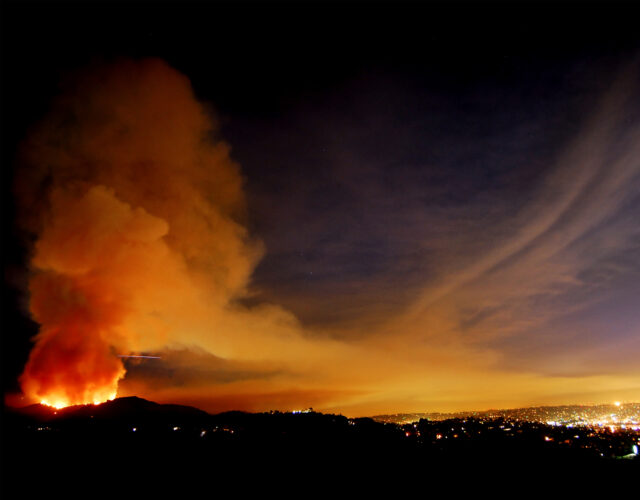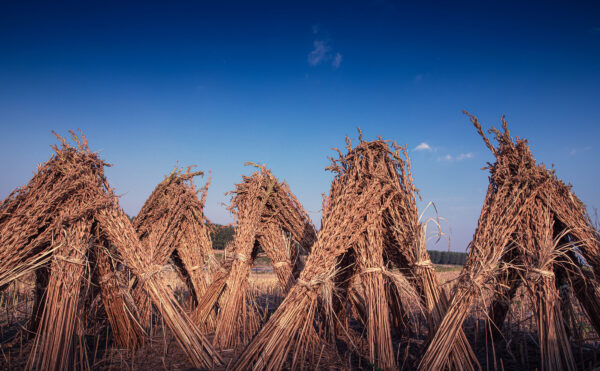America’s war on wildfire began in the late summer of 1910 in the hills of northern Idaho and western Montana. The season’s paltry rainfall had left the Northwest in drought. Lightning, campfires, and cinders from coal-burning trains sparked frequent blazes in dry underbrush. The resources of the five-year-old U.S. Forest Service were strained by the thousands of small wildfires burning through pine, cottonwood, and birch stands in the mountainous terrain. Still, through coordinated cutting and digging and with the help of the U.S. Army, the Forest Service managed to bring the fires under control. It looked like the region would escape the season without major damage.
But on August 20, gale-force winds rushed through the mountains and transformed them into a hurricane of fire, combining all of the small fires into one enormous blaze. Over the course of two days, three million acres of forest became a charred hellscape. At least 85 people were killed, and drifting ash blocked out the sun as far east as Watertown, New York. The fire was called the Big Blowup. Eyewitnesses described trees exploding from heat and fireballs leaping across valleys to ignite entire mountainsides in seconds. The blaze subsided within 48 hours after cool air and rain rolled in. No one understood how or why this fire spread so quickly.
The Big Blowup left a permanent impression on the people who witnessed it, none more so than Ferdinand A. Silcox, who fought the fire as a member of the Forest Service. Silcox, who in 1933 became the fifth chief of the service, believed that the only way to fight wildfires was to stamp them out before they could grow big enough to do real damage. He prioritized a tactic known as the “10 a.m.” policy, which mandated that all fires be suppressed by 10:00 a.m. the morning after their report. Fire was viewed as a scourge that destroyed land the Forest Service was meant to protect.
Wildfires in the United States became less common under Silcox and his successors. The Forest Service transformed into a well-funded organization with crews situated around the country. Resources and firefighters were strategically deployed on a massive scale, and technological improvements in communication allowed the Forest Service to react to blazes quickly. As meteorological sciences advanced, firefighters learned how to predict the likelihood of wildfires as well.
But these short-term successes created side effects unrecognized at the time. Silcox’s zero-tolerance policy is partially responsible for the massive fires that routinely blaze through America’s forests today. After nearly a century of fire-management practices based on Silcox’s ideas, fires have not been allowed to burn dead plant matter and underbrush regularly. When a wildfire is sparked, either by humans or other means, it has substantially more fuel to consume than in Silcox’s era. The extra fuel allows wildfires to burn longer and hotter and can lead to megafires. Unlike smaller fires, which burn away bushes and singe bark while leaving old-growth trees intact, megafires jump from underbrush to the upper canopy and turn entire forests into charcoal. Forests can survive most ordinary fires, but not a megafire.
During the 2014 fire season 60,000 wildfires burned through more than three million acres of forest, an area nearly the size of Connecticut. And 2014 was a relatively tame year by contemporary standards. In 2012, nearly 68,000 wildfires burned through nine million acres. Compare that with 1983, the first year the United States began compiling overall data on forest fires, when about 18,000 wildfires burned a little over one million acres. The cost of wildfire is even more daunting; the 2007 Witch Fire in California cost more than $1 billion in insured damages alone, an amount that does not include suppression costs and environmental effects. Megafires regularly reach that cost, especially if they burn through towns.
During the 2014 fire season 60,000 wildfires burned through more than three million acres of forest, an area nearly the size of Connecticut.
The field of forest-fire research is quite young. Not until the 1960s did scientists realize that wildfires can be postponed but cannot be prevented, and that the only way to completely prevent wildfires would be to cut down every forest in the country. As recently as the 1970s most scientists believed that fire could be explained with a simple two-dimensional model using distance and temperature to predict how fire spreads. Now fire scientists, such as those at the Fire Lab in Missoula, Montana, are creating far more sophisticated models. For instance, a three-dimensional model created by the Fire Lab treats fire as a fluid with the potential to move in any direction depending on air currents and the rate of fuel consumption.
While these computer models are new, our struggle to control forest fires is very old. Environmental historian Stephen J. Pyne holds that for as long as humans have recorded history, they have not encountered a forest unmodified by other humans. Early inhabitants of North America regularly burned forests to create space for grass to grow and game animals to graze. The Great Plains were likely maintained with such fire management. When Native American societies were decimated by disease, displacement, and war, their regular burning practices went with them. A handful of scientists and some conservationists deny the environmental impact of indigenous peoples, arguing more generally that there is little physical evidence that forest fires anywhere in the world were intentionally started by these groups. Still, written accounts of European explorers in North America, Australia, and everywhere in between recount the burning practices of the cultures they encountered in the 17th and 18th centuries.
In the early 2000s fire-management policy finally began shifting in a meaningful way to mirror what little is known about Native American methods. The few researchers who had advocated for controlled burning since the 1960s were vindicated by growing evidence: an increasing number of wildfires that, no matter the money and resources thrown at them, kept getting bigger. Even though the Forest Service began conducting controlled burns, many conservation organizations have been slow to adopt these practices; likewise, politicians have been reluctant to support them. Convincing the general public that setting small fires now to suppress large fires in the future is a hard sell. As a result, only a few million acres of the roughly 751 million acres of U.S. forestland are burned each year. Most of this controlled burning has occurred in Florida, which has been a pioneer in forest-management policy.
Not until the 1960s did scientists realize that wildfires can be postponed but cannot be prevented.
Accumulated debris and underbrush in forests is not the only contributor to megafires. According to precipitation data collected by the Environmental Protection Agency, parts of the United States are now significantly drier than in the 1980s, when there were relatively few wildfires. Not only is there more fire; there are more humans, too. The average death-by-wildfire toll has increased almost yearly for decades, with 34 firefighters dying in 2013 alone. Settlements are built closer to grasslands and forests at high risk of burning. If the Big Blowup happened now, many thousands more people, living in towns that did not previously exist, would be affected.
Fortunately the Forest Service has more tools today than it had in 1910. Fabrics made from fiberglass, aluminum, and silica have been used since the 1960s to create fire shelters that block heat. Firefighters deploy them as a last resort if trapped by flames. Foaming agents help water adhere to the sides of buildings and protects the structures from wildfire. One such product is named Firefoam 103b; one of its active ingredients is similar to the same chemical that makes shampoo sudsy.
When the Forest Service was first created, fires were fought with manual digging, cutting, and dousing with water. It is dangerous for firefighters to suppress fires on the ground, and so aerial deployment of fire retardants, such as diammonium phosphate, have become common. In the 1960s the rare prescribed burn involved a ranger lighting a match and running away. These days the Forest Service is able to spark controlled burns from helicopters using an ignition device that is essentially a Ping-Pong ball filled with potassium permanganate and ethylene glycol (antifreeze).
Even with a universal policy of controlled burning, full support from conservationists and politicians, and better technology, taming megafires will take time. Humans have always interfered with nature; it’s how we interfere that matters.




